Breitling, bringing science to time.?
Official Supplier to the World of Aviation
Leon Breitling – The Beginning of Breitling
Follow along this article for a brief history of the Breitling brand- a company with a legacy that still holds true today for its excellency and precision in timekeeping and its instruments. A classic brand in the industry, Breitling has a remarkable history not only in timepieces but also within aviation.
Founded in 1884 in St. Imier Switzerland by Leon Breitling, it is a company that has been heavily involved in aviation since the beginning.
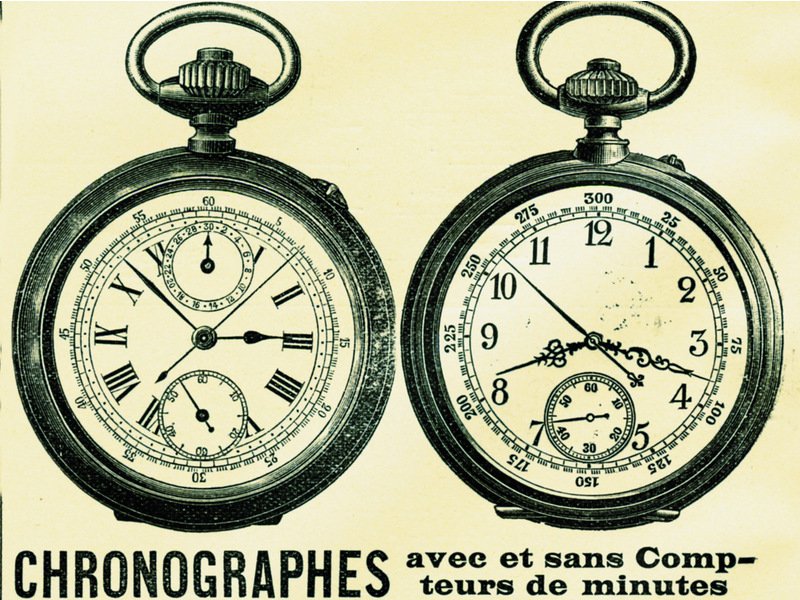
The Breitling brand was born in 1884, within Switzerland’s St. Imier through the efforts of Léon Breitling. It quickly gained a reputation both of quality and excellence and, due to their precision, were often used in sporting events and scientific fields.
What made their timepieces and brand remarkable was its sleek design, streamlined manufacturing processes and the relatively easy maintenance for such premium movements. Orders flooded in. The company expanded and moved to La-Chaux-de-Fonds and MontBrillant street, shifting from a smaller family business to a standardised production. Breitling saw wild success- within 26 years of its founding, Breitling sold its 100,000th unit in 1910.
It is notable in this time period, from its foundation in 1884 till 1910, Breitling patented and made numerous achievements in the world of chronology. A movement with an eight-day power reserve was patented in 1893. By 1896, a Breitling chronograph could be accurate to two-fifths of a second. The company was even remarkable in the medical field, creating a pulsograph with which doctors could measure a heart rate.
Through all of these advances, however, one is paramount and could be argued as foundational to the modern associations of Breitling- to measuring speed and mastering the laws of physics with utmost precision. Breitling’s Vitesse timer and tachymeter, invented in 1905, enabled its beholder to measure any speed between the range of 15 to 250 kilometers per hour. The Vitesse was used alike by civilian drivers and policemen to enforce or sustain lawful transport in Swiss cities.
Léon Breitling passed away in 1914, but in his time as the founder of Breitling, he grew the company from the innermost reaches of his mind and gave it the pillars with which it stands today- a brand of timekeeping built on precision and innovation for the betterment of people. He was succeeded by his son, Gaston Breitling, who headed Breitling for the next decade and over.
Gaston Breitling – The Innovator
1914 was a remarkable year for not only Breitling but more universally, the world. The assassination of Arch-duke Franz Ferdinand prompted the declaration of war bellowed by Austria-Hungary against Serbia- a conflict that deepened and festered into The Great War. Breitling’s innovations at this time proved invaluable, again contributing to its hard-won (and now, war-hardened) reputation for excellency in timekeeping.
Gaston Breitling oversaw the 1914 invention of a separate ‘pusher’ that was set above the wristwatch’s crown at the 2 O’clock marker on the dial. This allowed for the wearer to moderate the second-hand within the watch with more ease and thus, keep better track of exact, necessary increments- Two seconds. Five seconds. Ten. The push-piece, a small button, made it possible to start the second hand, stop it, or return it to zero entirely. This was vital in wartime, to measure the duration of time before an explosive detonated or more relevantly here, to aid pilots as they flew.

A Breitling watch featuring the single 2 O’Clock pusher, courtesy of https://marketplace.watchcharts.com/listing/11258211-wts-wtt-rare-breitling-transocean-1915.
Pre-1914, watches for men were namely pocket watches; a wristwatch was women’s wear. In World War I, however, time became literally of the essence, then-so more than ever. Soldiers and pilots did not have the time to dig through pockets to accurately gauge time. The independent pusher (“Monopusher”, as coined by Breitling) quickly became standard. It was easy to use in a pilot’s cockpit or a soldier’s trench, and many other watch companies followed suit. To this day, many Breitling models still come fitted with a pusher; wartime relic, remarkable invention and another example of the company’s devotion to timekeeping.
In 1923, Gaston separated the reset function from the pusher, leaving the button with only the stop and start functions of the second-hand, while resetting it entirely was relocated to the crown of the watch.
Gaston passed away in 1927, marking a 13-year leadership of the Breitling company. His son, Willy, was only 14 when he lost his father. It would be five years before he would succeed his father at the age of 19.
Willy Breitling -More Innovation, No Stone Unturned
1932 saw Willy Breitling assuming leadership of his grandfather’s company at the age of 19. At this time, Breitling’s profits were largely held in chronographs; over 40 models contributed to the heart of its business, sold often to aviation endeavours due to the tried and tested reputation of their timepieces.
Willy was young, but sought even more mastery within the mechanisms of chronographs. Only a year or two passed by before he secured a patent for a chronograph with two separate pushers; the crown’s function in resetting the minute hand was transferred to the second push-piece at 4 O’clock on the dial. To this day, this remains the standard chronograph model.
The progression of the modern chronograph didn’t stop there; under Willy Breitling’s instruction, Breitling’s designs became even more well-equipped for militant use, aviation and even naval use. The Huit division founded by Willy was devoted to creating the perfect cockpit aviation wristwatches and later on, the Clamshell Breitling model was the first of its kind- resistant to dust and damage from water due to an innovative case design.
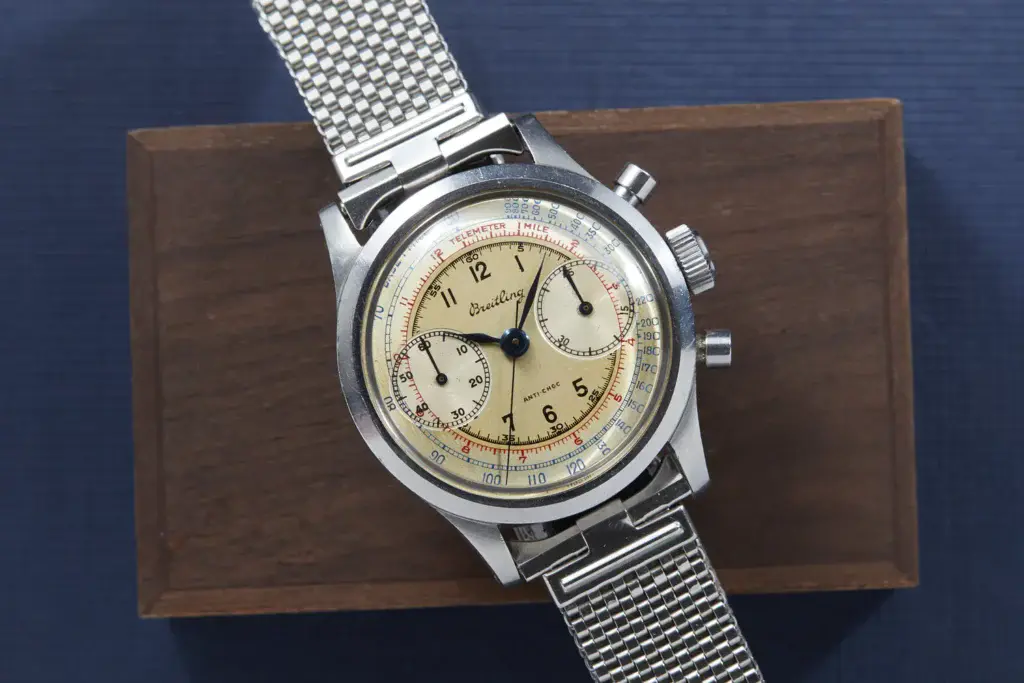
A Breitling Clamshell, produced sometime in the early 1940’s. Image courtesy of Analog Shift, https://www.analogshift.com/products/breitling-clamshell-chronograph.
These inventions became the industry standard and a clear signifier of the Breitling watch; sleek, mindful design, suited for the wearer’s needs in any field of extreme speed or science.
Willy’s time in Breitling only brought the brand even more prestige and brilliance; in his time, Breitling officially supplied the British Royal Air Force with cockpit watches through the Huit division. The 30’s for the company also saw a particular aviator chronograph that sported a black dial, luminescent hands and numerals as well as a rotating bezel and pointer arrow.
The Second World War also shed light into the resilience of Breitling as both a company and in its leadership. By nature of its geography, Breitling had been placed under Axis pressure to prohibit the export of their timepieces to The Allies; Willy Breitling himself resisted against this, meeting planes in the fields nearby the factory to smuggle chronographs abroad. Himself and his friends would use automobiles to direct planes to runways and light them up in order to ensure the pilots could safely take off with their cargo. Even in restricted wartime, Breitling continued to innovate. The 1942 introduction of the Chronomat allowed for its wearer to make mathematical calculations of distance and coordinates in the go- invaluable in the case of pilots, thanks to its circular slide rule.
In 1942 Breitling introduces the Chronomat with a circular slide rule.
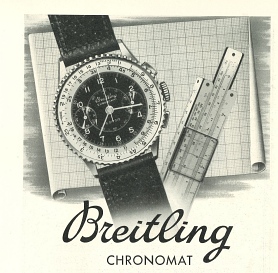
These functions were only improved upon in the Navitimer (Navigation Timer), released in 1952. As its name suggests, the Navitimer was aviation and flight-specific within its slide rule and rotational bezel, which allowed for any flight to be calculated meticulously in distance, time and speed. Its iconic design is still produced to this day.
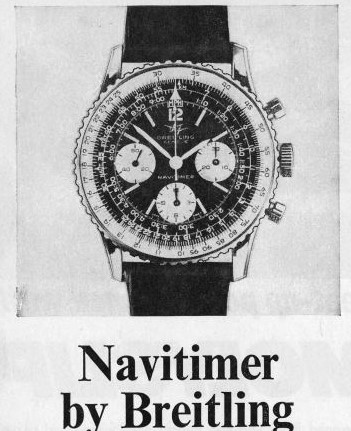
A Computer that tells you the Time Navitimer by Brietling
The Aircraft Owners and Pilots Association (AOPA), was quick to adopt the Navitimer as its official watch and features its winged logo on the dial a mere two years after Breitling began its production; at this time, the company supplied many major airlines with cockpit clocks and pilots their watches. By the 50’s, Willy Breitling also moved to create the Co-Pilot watch, ref. 765, with luminous numerals and a large dial that could be worn by pilots of any stripes.
1957 saw the creation of the Super Ocean: A Breitling model that was waterproof to 20 bar (200 meters, 660 feet) with a reference number of 807. The Super Ocean led to the TransOcean, an even more remarkable design with a shock-proof, anti-magnetic movement and a super sealed case for a truly waterproof timepiece. With both models, Breitling was now found in both the air and the seas.
The TransOcean shock-proof, anti-magnetic, super sealed timepiece.
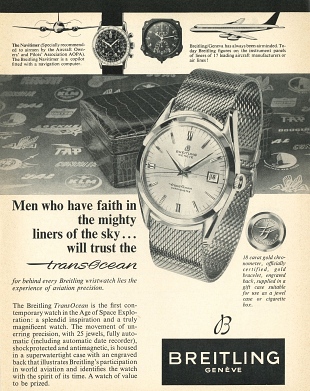
In 1969, the Breitling company in collaboration with Heuer introduced the legendary Calibre 11. Arguably the first self-winging chronograph movement. The Huer Monaco and Breitling Chrono-Matic collections were based on the Calibre 11.
Moving Forward- The Schneiders and Quartz
The 1970’s saw the doom of countless watch companies. Swiss watch brands are unmatchable in both design and movement. Automatic movements are expensive and meticulous, threaded with expensive jewels and even more expensive maintenance. Swiss brands held an iron, 31-jeweled fist over the international market for timekeeping in terms of excellence and quality.
Until Seiko’s Astron hit markets in 1969. The very first watch not to run on rubies but rather on quartz, and it absolutely shattered the Swiss ideal of excellence at the time. Willy, in all of his adaptive mindset and innovation, understood that the Breitling brand and inventions must be preserved. His declining health brought him too many challenges to face alongside an upstart competitor and thus, ownership of the Breitling company passed out of its original family and to Ernest Schneider in 1979. A pilot, watchmaker and micro-electronics specialist, Schneider had ambitions to save Breitling from the Quartz movement crisis- and succeeded.
Underneath the Schneider family, Breitling adapted to the trending Quartz movements through releases such as the Aerospace in 1985 (featuring both a digital and analog display) and a revival of the Navitimer in 1986. Other amazing timepieces also were proven worthy in this time, fitted with Schneider’s flare for blending Breitling’s classic mechanics with new technology and functions. The Emergency watch (1995) came with an ELT (Emergency Locator Transmitter) for any disasters, along with an emergency power reserve and an antenna system that Schneider had worked closely in collaboration with Dassault Electronique to develop. introduced, combining traditional watch elements with smart phone connectivity.
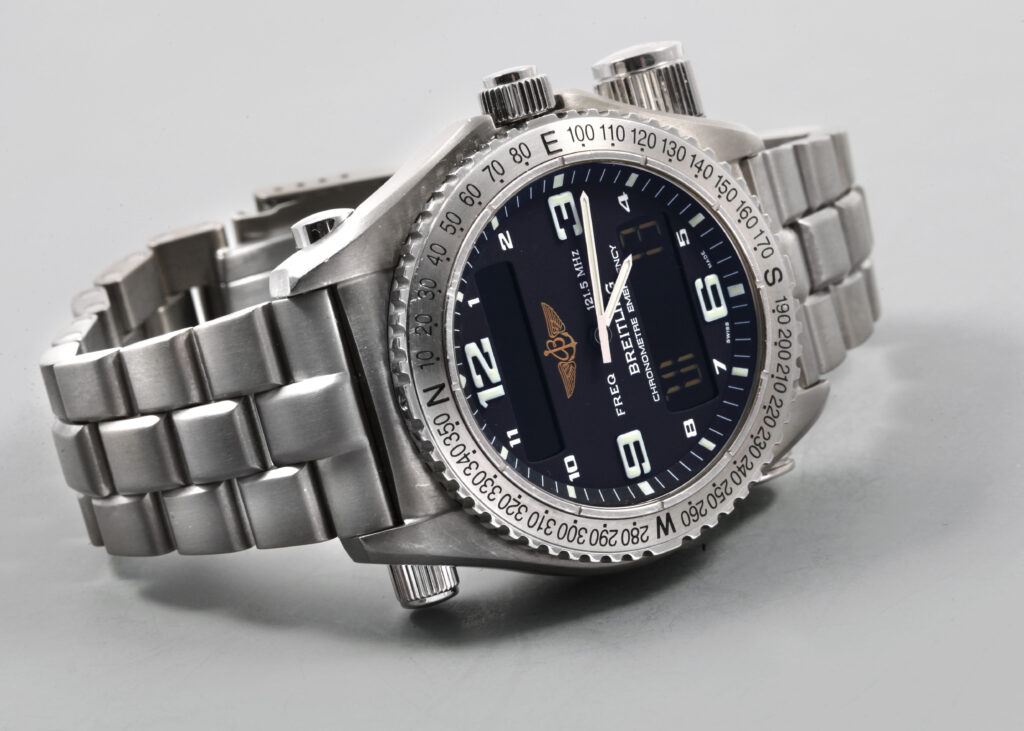
The 1995 Breitling Emergency, courtesy of https://www.swisswatchexpo.com/thewatchclub/2023/06/15/breitling-emergency-watch/.
In 2009, Breitling introduced the Calibre-01 to the market: The brand’s most precise self-winding movement in a chronograph, a movement that still holds gold standard in markets today. Many other models in this time were notable, such as the Chronospace in 2010 and the Exospace in 2015. By 2016, Breitling had again caught along with the craze for a smart watch, releasing the B55-Connected which was capable of connecting to its wearer’s phone.
In 2017, the Shneider family’s guardianship of Breitling was given over to CVC Capital, marking the end of a near 40-year Breitling era that had seen the rise of a new, technological era and the ability of Breitling as a company to adapt.
The Present
CVC Capital has since begun to revive several old Breitling models, with Georges Kern as the company’s CEO. Many of these include the Navitimer or the SuperOcean into the SuperOcean Heritage, combining old, timeless design with modern innovation in movements. Breitling’s time beneath new leadership has been brief, but will see new inventions, designs and movements in the time coming, cementing its legacy and awesome reputation in the watchmaking industry as an icon.

